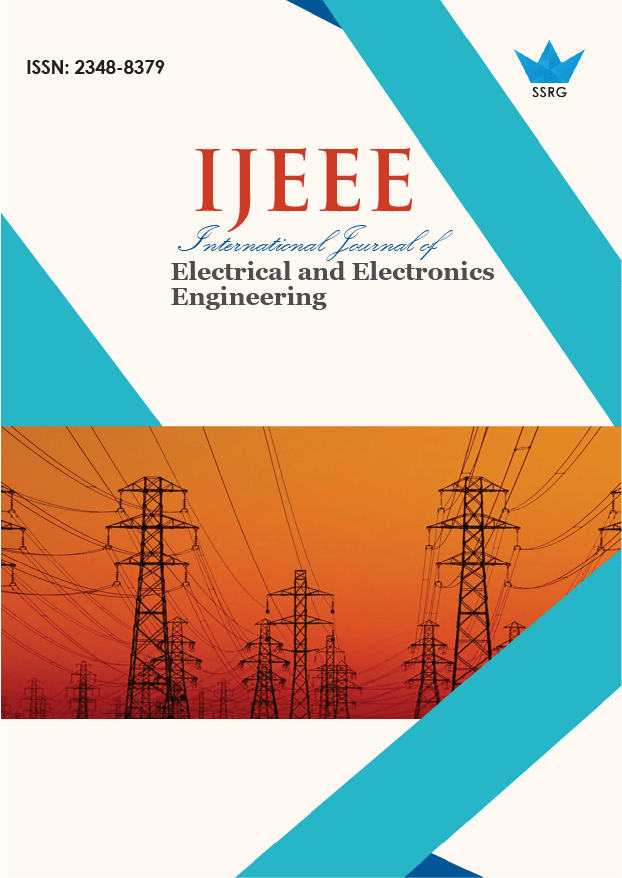Remote-Controlled Cooling System for Chrome Plating Cells Using Industrial IoT and MODBUS TCP/IP

| International Journal of Electrical and Electronics Engineering |
| © 2025 by SSRG - IJEEE Journal |
| Volume 12 Issue 6 |
| Year of Publication : 2025 |
| Authors : Julio Andre Ramirez Ramirez, Dennis Benjamin Montalvo Hurtado, Alexander Hilario-Tacuri |
How to Cite?
Julio Andre Ramirez Ramirez, Dennis Benjamin Montalvo Hurtado, Alexander Hilario-Tacuri, "Remote-Controlled Cooling System for Chrome Plating Cells Using Industrial IoT and MODBUS TCP/IP," SSRG International Journal of Electrical and Electronics Engineering, vol. 12, no. 6, pp. 214-223, 2025. Crossref, https://doi.org/10.14445/23488379/IJEEE-V12I6P119
Abstract:
This project proposes an electronic control solution to improve thermal management during the electroplating process in chrome plating cells, using a cooling tower control system and an intelligent cooling process. Using RTD sensors to monitor temperature in real time, electronic solenoid valves to regulate coolant flow, an electronic card capable of communicating between devices, and control strategies to maintain stable temperatures in each cell, this system ensures precise and efficient control of thermal conditions throughout the chrome plating process, reducing response time by up to 96.67%). The integration of the ATMEGA 328P microcontroller, S7-1200 PLC and MODBUS TCP IP communication protocol, together with the visualization through a real-time monitoring peripheral, will allow operators to manage the system remotely, optimizing not only the coolant flow but also the product quality. In this way, the system not only ensures a more controlled and efficient process but also contributes to reducing operating costs and extending the useful life of the equipment in the event of manual operation deficiencies.
Keywords:
Electroplating Process Optimization, Smart Cooling Control System, Temperature Monitoring with RTD Sensors, PLC and Microcontroller Integration, MODBUS TCP/IP Industrial Communication.
References:
[1] Shichao Zhao et al., “Corrosion Behavior and Mechanism of Carbon Steel in Industrial Circulating Cooling Water System Operated by Electrochemical Descaling Technology,” Journal of Cleaner Production, vol. 434, 2024.
[CrossRef] [Google Scholar] [Publisher Link]
[2] Priyabrata Banerjee et al., Scale Inhibitors for Cooling Towers and Industrial Circulating Systems,” Industrial Scale Inhibition: Principles, Design, and Applications, Wiley, pp. 370-398, 2024.
[CrossRef] [Google Scholar] [Publisher Link]
[3] Qiu-na Wang et al., “Subsection Cooling System of Hot Rolling Silicon Steel and its Industrial Application,” Journal of Iron and Steel Research International, vol. 32, pp. 159-170, 2024.
[CrossRef] [Google Scholar] [Publisher Link]
[4] Morteza Alizade et al., “Experimental Study on the Effects of Different Phase Change Materials for Increasing the Cooling Rate of Industrial Electronic Systems by Using a Heat Exchanger with the Specific Heat Sink,” Journal of Energy Storage, vol. 55, 2022.
[CrossRef] [Google Scholar] [Publisher Link]
[5] Xu Zhou et al., “Experimental and Numerical Investigation on the Performance of a Closed-Wet Cooling Tower (CWCT) Integrated into the Underground Exhaust Air Channel,” Applied Thermal Engineering, vol. 271, 2025.
[CrossRef] [Google Scholar] [Publisher Link]
[6] Liu Shiqi et al., “A Novel Flexible Analysis Approach of Recirculating Cooling Water System Integrated Cooling Tower and Cooling Water Network,” Applied Thermal Engineering, vol. 265, 2025.
[CrossRef] [Google Scholar] [Publisher Link]
[7] Ekaterina A. Pecherskaya, Anatoly D. Semenov, and Pavel E. Golubkov, “Simulation of Electrical Parameters of a Galvanic Cell in the Process of Microarc Oxidation,” Frontier Materials and Technologies, no. 4, pp. 73-85, 2023.
[CrossRef] [Google Scholar] [Publisher Link]
[8] Jamil H. Sacaca Ramos et al., Real-Time Monitoring of Constant Pressure and Variable Frequency Drive Motor in a Control Plant Using Modbus TCP/IP, IoT Core, MQTT, and Grafana, Business Sustainability with Artificial Intelligence (AI): Challenges and Opportunities, vol. 1, pp. 881-890, 2024.
[CrossRef] [Google Scholar] [Publisher Link]
[9] Yanpeng Zheng et al., “Design of a Multi-Channel PID Temperature Control System Based on PLC and Internet of Things (IOT),” Journal of Electrical Engineering and Technology, vol. 20, pp. 721-735, 2024.
[CrossRef] [Google Scholar] [Publisher Link]
[10] Thanachok Subhagandha, and Sungwan Boksuwan “Developing Efficient Temperature Control for HERMS: A Study on P, P-Logic, PI, and PID Controllers,” 2025 Fourth International Symposium on Instrumentation, Control, Artificial Intelligence, and Robotics (ICA-SYMP), Bangkok, Thailand, pp. 23-26, 2025.
[CrossRef] [Google Scholar] [Publisher Link]
[11] Ruiming Yu et al., “Study on the Design of Single-Seat Control Valve with Stable Flow Regulation and its Fluid Flow Characteristics and Thermal Stress,” Flow Measurement and Instrumentation, vol. 95, 2024.
[CrossRef] [Google Scholar] [Publisher Link]
[12] Vijaykumar Bhanuse et al., “Smart Servo-Operated Ball Valve with IoT Integration and PID Control for Precise Fluid Management,” 2025 International Conference on Intelligent and Innovative Technologies in Computing, Electrical and Electronics (IITCEE), Bangalore, India, pp. 1-5, 2025.
[CrossRef] [Google Scholar] [Publisher Link]

 10.14445/23488379/IJEEE-V12I6P119
10.14445/23488379/IJEEE-V12I6P119